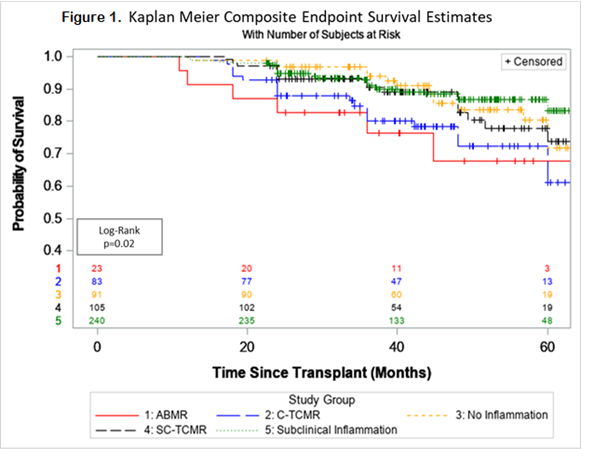Impact of T-cell Mediated Allograft Rejection and Antibody Mediated Rejection within the First Year after Kidney Transplantation
Thomas E. Starzl Institute of Transplantation and Division of Transplant Nephrology, UPMC, Pittsburgh, PA
Meeting: 2019 American Transplant Congress
Abstract number: C173
Keywords: Biopsy, Graft function, Inflammation, Rejection
Session Information
Session Name: Poster Session C: Kidney: Acute Cellular Rejection
Session Type: Poster Session
Date: Monday, June 3, 2019
Session Time: 6:00pm-7:00pm
 Presentation Time: 6:00pm-7:00pm
Presentation Time: 6:00pm-7:00pm
Location: Hall C & D
*Purpose: This study evaluated the impact of Clinical and Sub-clinical T-Cell-Mediated Rejection (TCMR), Sub-Clinical Inflammation and Antibody Mediated Rejection (ABMR) within the 1st year post-kidney transplantation.
*Methods: Kidney transplant patients who underwent protocol biopsies at 3 and 12 were included. We excluded transplant recipients with BKV nephritis, graft loss and patient loss within one year. We sub-classified patients into 5-groups (GR): GR-I: No inflammation (NI), GR-II: Subclinical-Inflammation (SCI), GR-III: SC-TCMR, GR-IV: C-TCMR and GR-V: ABMR. Cumulative allograft histology for acute (i+t+v+g) and chronic (ci+ct+cv+cg) inflammation were analyzed. The burden of renal disease was calculated using Area Under the Curve (AUC: serum creatinine mg*month/dL) for each group. In addition, Graft-Loss, Impending Graft-Loss (eGFR<20 mL/min per 1.73 m2) and Patient-Loss were measured.
*Results: Recipient and donor demographics and transplant variables were similar across groups. Table 1 shows worse renal function measured by cumulative AUC over long term among patients in the ABMR and C-TCMR groups. Higher rates of graft loss, impending graft loss were noted among patients with ABMR and C-TCMR as opposed to NI, SCI- and SC-TCMR groups. The cumulative acute and chronic allograft scores were higher among patients with SC-TCMR, C-TCMR and ABMR in both 3/12-month biopsies.Figure 1 shows lower impending graft survival among ABMR and C-TCMR groups (p=0.02)
*Conclusions: C-ABMR and C-TCMR within the 1st year were associated with higher allograft acute and chronic scores, progressive renal dysfunction and lower impending graft survival.
| Outcome | GR-I(No Inflammation) n=93 | GR- II (Subclinical Inflammation)n=240 | GR-III (SC-TCMR)n=106 | GR-IV(C-TCMR)n=83 | GR-V(ABMR) n=24 | p |
| Graft loss,% | 7.6 | 3.8 | 5.7 | 8.4 | 12 | 0.01 |
| Graft loss/impending GL,% | 13 | 8.3 | 14.2 | 20.5 | 29.2 | 0.01 |
| GFR AUC Mean±SD | 1810±72 | 1684±44 | 1636±67 | 1493±75 | 1534±142 | <0.001 |
| 3/12 month acute score >2,% | 0/3.9 | 11.3/11.8 | 51.8/73.1 | 67.5/68.3 | 60.9/61.5 | <0.001 |
| 3/12 month chronic score>2, % | 13.1/33.3 | 31.3/53.2 | 45.2/72 | 62.5/76.7 | 52.2/53.9 | <0.001 |
To cite this abstract in AMA style:
Owoyemi I, Jorgensen D, Tandukar S, Mehta R, Hariharan S. Impact of T-cell Mediated Allograft Rejection and Antibody Mediated Rejection within the First Year after Kidney Transplantation [abstract]. Am J Transplant. 2019; 19 (suppl 3). https://atcmeetingabstracts.com/abstract/impact-of-t-cell-mediated-allograft-rejection-and-antibody-mediated-rejection-within-the-first-year-after-kidney-transplantation/. Accessed January 7, 2026.« Back to 2019 American Transplant Congress

